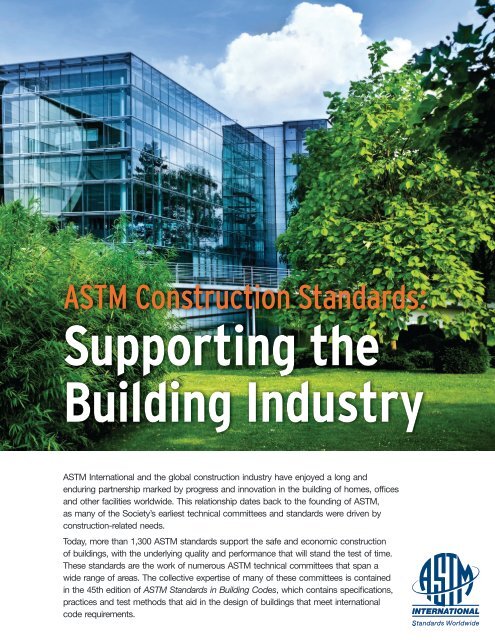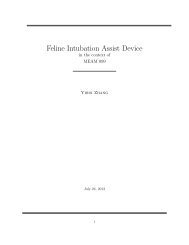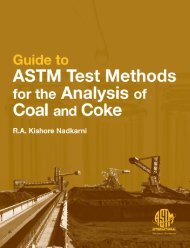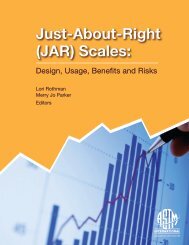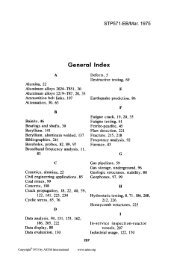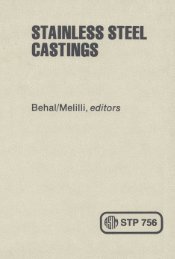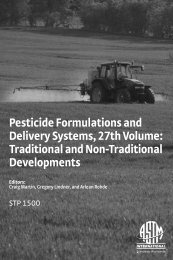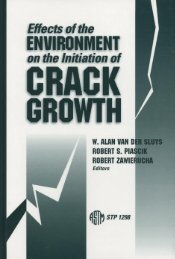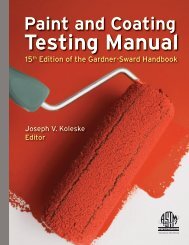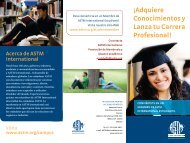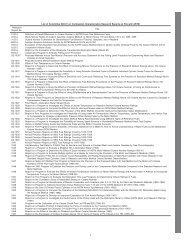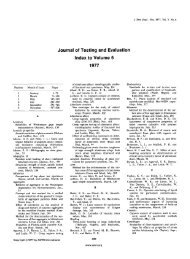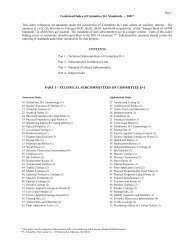ASTM Construction Standards: Supporting the Building Industry
ASTM Construction Standards: Supporting the Building Industry
ASTM Construction Standards: Supporting the Building Industry
Create successful ePaper yourself
Turn your PDF publications into a flip-book with our unique Google optimized e-Paper software.
<strong>ASTM</strong> <strong>Construction</strong> <strong>Standards</strong>:<br />
<strong>Supporting</strong> <strong>the</strong><br />
<strong>Building</strong> <strong>Industry</strong><br />
<strong>ASTM</strong> International and <strong>the</strong> global construction industry have enjoyed a long and<br />
enduring partnership marked by progress and innovation in <strong>the</strong> building of homes, offices<br />
and o<strong>the</strong>r facilities worldwide. This relationship dates back to <strong>the</strong> founding of <strong>ASTM</strong>,<br />
as many of <strong>the</strong> Society’s earliest technical committees and standards were driven by<br />
construction-related needs.<br />
Today, more than 1,300 <strong>ASTM</strong> standards support <strong>the</strong> safe and economic construction<br />
of buildings, with <strong>the</strong> underlying quality and performance that will stand <strong>the</strong> test of time.<br />
These standards are <strong>the</strong> work of numerous <strong>ASTM</strong> technical committees that span a<br />
wide range of areas. The collective expertise of many of <strong>the</strong>se committees is contained<br />
in <strong>the</strong> 45th edition of <strong>ASTM</strong> <strong>Standards</strong> in <strong>Building</strong> Codes, which contains specifications,<br />
practices and test methods that aid in <strong>the</strong> design of buildings that meet international<br />
code requirements.<br />
www.astm.org <strong>ASTM</strong> ConSTruCTion STAndArdS: SupporTing The <strong>Building</strong> induSTry
2<br />
LAyIng The FoundATIon: C01 And C09<br />
<strong>Standards</strong> from <strong>ASTM</strong> Committees C01 on Cement and C09 on<br />
Concrete and Concrete Aggregates have long played a significant<br />
role in <strong>the</strong> worldwide construction industry.<br />
Committee C01 on Cement was organized in 1902 to address<br />
<strong>the</strong> need for uniform test methods. From <strong>the</strong> start, Committee<br />
C01 has been a model of stakeholder collaboration and consensus<br />
standards development that is <strong>the</strong> hallmark of <strong>the</strong> <strong>ASTM</strong> International<br />
process. With a number of government and industry<br />
organizations, including <strong>the</strong> influential American Association of<br />
Portland Cement Manufacturers (later called <strong>the</strong> Portland Cement<br />
Association), all involved in <strong>the</strong> emerging cement industry in <strong>the</strong><br />
early 1900s, <strong>ASTM</strong> offered <strong>the</strong> opportunity for balanced participation<br />
in creating uniform specifications and test methods.<br />
Committee C01 released its first standard in 1904: <strong>ASTM</strong> C9,<br />
Standard Specification for Cement. The standard was embraced<br />
by stakeholders, including manufacturers, engineers, architects<br />
and government agencies. Moreover, <strong>the</strong> release of <strong>the</strong> <strong>ASTM</strong> C9<br />
standard turned out to be a watershed event for <strong>the</strong> young U.S.<br />
construction industry. With a single specification covering all<br />
general construction cement used in <strong>the</strong> United States, cement<br />
shipments and consumption nearly tripled in <strong>the</strong> next ten years,<br />
driving dramatic industry growth.<br />
C150: The gLobAL CeMenT STAndArd<br />
Specification C9 was <strong>the</strong> forerunner to ano<strong>the</strong>r standard that today<br />
is <strong>the</strong> bellwe<strong>the</strong>r specification for cement in <strong>the</strong> worldwide<br />
construction industry — <strong>ASTM</strong> C150/C150M, Specification<br />
for Portland Cement, which covers <strong>the</strong> physical and chemical<br />
requirements for manufacturing eight types of portland cement,<br />
<strong>the</strong> basic ingredient of concrete. C150 is universally adopted<br />
and utilized in <strong>the</strong> construction industry by cement manufacturers<br />
and purchasers as well as concrete producers, specifiers<br />
and users.<br />
Over <strong>the</strong> years, C150 has been revised to address changing<br />
industry needs, ensuring <strong>the</strong> standard’s ongoing vitality in building<br />
quality and performance. Recent revisions have focused on<br />
base cement technology improvements to achieve environmentalrelated<br />
benefits and to support sustainable construction goals.<br />
For example, C150 has been revised to include <strong>the</strong> inter-grinding<br />
of limestone, which helps reduce <strong>the</strong> energy-intensive process of<br />
grinding clinker to create cement. In addition, C150 specifies <strong>the</strong><br />
technically sound inclusion of slag (a steel processing byproduct)<br />
and fly ash (a coal processing byproduct) in cement, allowing for<br />
<strong>the</strong> productive re-use of <strong>the</strong>se industrial waste materials.<br />
C01 PerForMAnCe STAndArdS:<br />
AdvAnCIng The durAbILITy oF CeMenT<br />
<strong>ASTM</strong> Committee C01 is also investing in <strong>the</strong> ongoing enhancement<br />
of cement performance standards. While standards<br />
such as C150 and C595/C595M, Specification for Blended<br />
Hydraulic Cements, address both prescriptive and performance<br />
requirements, o<strong>the</strong>rs, such as C1157/C1157M, Performance<br />
Specification for Hydraulic Cement, are principally focused on<br />
durability and performance. C1157 specifies cements based on<br />
requirements for general use, high early strength, resistance to<br />
sulfates attack and heat of hydration.<br />
C01 Updates<br />
k Committee C01 has organized Subcommittee C01.98 on<br />
Sustainability Assessment, which has a scope of developing<br />
standards for <strong>the</strong> manufacture and use of hydraulic cement.<br />
k The recently issued C1749, Guide for Measurement of <strong>the</strong><br />
Rheological Properties of Hydraulic Cementitious Paste Using<br />
a Rotational Rheometer, is designed to determine yield<br />
stress and plastic viscosity.<br />
k C1738, Practice for High-Shear Mixing of Hydraulic Cement<br />
Pastes, has been published; <strong>the</strong> standard covers <strong>the</strong><br />
process used by operators conducting measurements using<br />
fresh (before setting) cement paste.<br />
k WK27311, Test Method for Measurement of Cement Paste<br />
Consistency Using a Mini-Slump Cone, is a proposed<br />
standard now under way; WK27311 would be used to predict<br />
cement consistency and assess early stiffening risk.<br />
CoMMITTee C09: The AuThorITATIve<br />
SourCe For ConCreTe STAndArdS<br />
A dozen years following <strong>the</strong> Committee C01 startup, Committee<br />
C09 was formed in 1914 to address standardization requirements<br />
for concrete. Today, Committee C09 has a membership of more<br />
than 1,200, including more than 100 participants from outside<br />
<strong>the</strong> United States. More than 30 technical subcommittees have jurisdiction<br />
over 170+ standards pertaining to concrete and related<br />
materials. Like those from Committee C01, <strong>the</strong> standards created<br />
by Committee C09 are woven into <strong>the</strong> day-to-day workings of<br />
<strong>the</strong> construction industry. For example, C09 standards such as<br />
C94/C94M, Specification for Ready-Mixed Concrete, cover<br />
fresh, unhardened ready-mixed concrete.<br />
AddreSSIng new TeChnoLogIeS<br />
Recently, Committee C09 has applied its expertise in developing<br />
test methods that support <strong>the</strong> advancement of new concrete technologies.<br />
One area of focus is pervious concrete, an environmentally<br />
friendly technology that provides communities with a better<br />
solution for stormwater management. Pervious concrete captures<br />
stormwater and allows it to seep into <strong>the</strong> ground, reducing runoff<br />
and helping to meet U.S. Environmental Protection Agency<br />
stormwater regulations. Because of its porous nature, pervious<br />
concrete cannot be tested using traditional concrete standards.<br />
Subcommittee C09.49 on Pervious Concrete has begun to<br />
fill <strong>the</strong> standards void with its first method specific to pervious<br />
concrete. C1688/C1688M, Test Method for Density and<br />
Void Content of Freshly Mixed Pervious Concrete, is used as a<br />
means to verify that <strong>the</strong> pervious concrete delivered to a project<br />
corresponds to <strong>the</strong> producer’s mix proportions.<br />
Ano<strong>the</strong>r technology that Committee C09 is addressing is<br />
self-consolidating concrete/high-performance concrete, which can<br />
flow easily into tight and constricted spaces without segregating<br />
and without requiring vibration. The committee has released new<br />
<strong>ASTM</strong> ConSTruCTion STAndArdS: SupporTing The <strong>Building</strong> induSTry www.astm.org
tests to measure <strong>the</strong> stability and consistency of self-consolidating<br />
concrete. These include C1621/C1621M, Test Method for Passing<br />
Ability of Self-Consolidating Concrete by J-Ring, which is<br />
used in <strong>the</strong> mix design phase of self-consolidating concrete to assure<br />
proper mix optimization. It can also be used for production<br />
consistency quality control. Serving a similar purpose is ano<strong>the</strong>r<br />
C09 standard, C1610/C1610M, Test Method for Static Segregation<br />
of Self-Consolidating Concrete Using Column Technique.<br />
Cohesive self-consolidating concrete is especially important for<br />
deep-section applications such as walls or columns. As a result,<br />
<strong>the</strong> degree of segregation, as measured by <strong>the</strong> C1610 test, can<br />
indicate <strong>the</strong> suitability of a concrete mixture for its purpose.<br />
C09 Updates<br />
k A proposed standard, WK35250, Practice for Fiber-Reinforced<br />
Concrete for Making and Curing Test Specimens in<br />
<strong>the</strong> Laboratory and Field, addresses <strong>the</strong> particulars of making<br />
consistent fiber-reinforced concrete test specimens.<br />
k A standard method to make roller-compacted concrete cylindrical<br />
specimens in a gyratory compactor is being developed:<br />
WK33682, Test Method for Preparation, Compaction and<br />
Density Determination of Roller-Compacted Concrete<br />
Specimens by Means of <strong>the</strong><br />
Superpave Gyratory Compactor.<br />
k WK34078, Specification<br />
for Lightweight Aggregate for<br />
Internal Curing of Concrete,<br />
covers <strong>the</strong> use of lightweight<br />
aggregate to increase concrete<br />
durability and service life; it<br />
will be useful in a variety of<br />
civil engineering projects.<br />
C01 And C09:<br />
CoLLAborATIon<br />
For ProgreSS<br />
Owing to <strong>the</strong>ir synergistic<br />
missions, <strong>ASTM</strong> International<br />
Committees C01 and C09<br />
often work closely toge<strong>the</strong>r<br />
to achieve common goals.<br />
One notable area of collaboration<br />
is a joint subcommittee,<br />
C09.48/C01.48 on<br />
Performance of Cementitious<br />
Materials and Admixture<br />
Combinations. The group’s<br />
aim is to develop standards<br />
for investigating interactions<br />
and for evaluating changes<br />
in early-age properties when<br />
various combinations of hydraulic<br />
cements, supplementary<br />
cementitious materials,<br />
o<strong>the</strong>r finely divided materials, water and chemical admixtures<br />
are used in cementitious mixtures. The subcommittee has completed<br />
its first standard, <strong>ASTM</strong> C1679, Practice for Measuring<br />
Hydration Kinetics of Hydraulic Cementitious Mixtures<br />
Using Iso<strong>the</strong>rmal Calorimetry. C1679 guides <strong>the</strong> investigation<br />
of <strong>the</strong> interactions and compatibility of various materials used<br />
to produce concrete.<br />
Committees C01 and C09 have also collaborated to organize<br />
Subcommittee C09.50 on Risk Management for Alkali-Aggregate<br />
Reactions, which is developing standards on mitigating deleterious<br />
alkali-aggregate reactions in concrete. Ano<strong>the</strong>r important,<br />
longstanding area of collaboration between Committees C01 and<br />
C09 is <strong>the</strong> joint sponsorship and management of <strong>the</strong> Cement and<br />
Concrete Reference Laboratory (CCRL). Through its laboratory<br />
inspection and proficiency sample programs, CCRL collects<br />
data useful in developing cement and concrete standards and to<br />
program participants. Materials included in <strong>the</strong>se programs are<br />
portland, blended and masonry cements; portland cement concrete,<br />
pozzolans, masonry mortar and concrete masonry units. As<br />
of <strong>the</strong> beginning of 2012, close to 1,900 laboratories in more than<br />
50 countries, including <strong>the</strong> United States, participate in <strong>the</strong>se<br />
programs.<br />
www.astm.org <strong>ASTM</strong> ConSTruCTion STAndArdS: SupporTing The <strong>Building</strong> induSTry<br />
3
4<br />
d08: KeePIng buILdIngS SAFe And dry<br />
Ano<strong>the</strong>r longstanding <strong>ASTM</strong> committee that has had an enduring<br />
impact on building construction is Committee D08 on Roofing<br />
and Waterproofing. Formed in 1905, Committee D08 has<br />
grown to more than 500 members who continue to deliver innovative<br />
standards solutions that protect consumers and provide a<br />
common language in <strong>the</strong> marketplace. With more than 10 technical<br />
subcommittees, D08 is responsible for over 150 standards for<br />
roofing and waterproofing materials, products and systems largely<br />
composed of organic materials such as asphalt, coal-tar, polymer<br />
modifiers and rubbers. Considering that all buildings require<br />
roofing and waterproofing, <strong>the</strong> importance of D08 standards can<br />
be felt virtually everywhere.<br />
While part of D08’s early years were spent addressing <strong>the</strong><br />
need for core specifications used by roofing and waterproofing<br />
product manufacturers, <strong>the</strong> group’s activities have evolved to deliver<br />
standards that help define <strong>the</strong> expected reliability of finished<br />
products. D08 standards such as D7158/D7158M, Test Method<br />
for Wind Resistance of Asphalt Shingles, help firms meet <strong>the</strong><br />
performance and safety expectations of consumers.<br />
New roofing and waterproofing innovations during <strong>the</strong> last<br />
two decades, as well as changes to traditional bituminous roofing<br />
technologies, have brought forward Committee D08’s continued<br />
responsiveness. This is evidenced by <strong>the</strong> release of standards to<br />
address industry changes, including <strong>ASTM</strong> D7349/D7349M, Test<br />
Method for Determining <strong>the</strong> Capability of Roofing and Waterproofing<br />
Materials to Seal Around Fasteners. D7349 measures<br />
water migration resistance at <strong>the</strong> point of penetration. Ano<strong>the</strong>r<br />
standard, D7379, Test Methods for Strength of Modified Bitumen<br />
Sheet Material Laps Using Cold Process Adhesive, addresses <strong>the</strong><br />
use of cold process adhesives in modified bitumen roofing systems.<br />
D08 Updates<br />
k D7492/D7492M, Guide for Use of Drainage System Media<br />
with Waterproofing Systems, has been published; it covers<br />
information about selecting and installing systems used to<br />
promote drainage around <strong>the</strong> foundations of buildings and<br />
on plazas.<br />
k A standard from D08.20 on Roofing Membrane Systems<br />
provides details about roof condition assessment as well as<br />
how to prepare a roof for coating: D7120/D7120M, Guide<br />
for Evaluation and Preparation of Roof Membranes for<br />
Coating Application.<br />
k A proposed vegetative roofing system standard, WK29304, is<br />
being developed to address <strong>the</strong> proper roofing and waterproofing<br />
membranes for a particular system.<br />
heLPIng ownerS And oCCuPAnTS<br />
While numerous <strong>ASTM</strong> committees contribute to <strong>the</strong> construction<br />
industry through material- and product-related standards,<br />
ano<strong>the</strong>r committee helps to ensure better building performance<br />
and management: <strong>ASTM</strong> Committee E06 on Performance of<br />
<strong>Building</strong>s. Formed in 1946 during <strong>the</strong> post-war building boom,<br />
Committee E06 addresses topics related to <strong>the</strong> overall performance,<br />
improvement and management of buildings and related<br />
facilities. Working on one or more of 15+ technical subcom-<br />
mittees, E06’s broad global membership of 1,100 experts creates<br />
standards that assist building developers, owners and occupants<br />
in a number of areas pertaining to building health and safety.<br />
One important role that Committee E06 fills is with standards<br />
pertaining to radon testing, lead contamination and asbestos<br />
control. The latter issue is <strong>the</strong> focus of Subcommittee E06.24 on<br />
<strong>Building</strong> Preservation and Rehabilitation Technology, which has<br />
published a series of standards that guides building owners in better<br />
managing asbestos. Notable among <strong>the</strong>se standards is E1368,<br />
Practice for Visual Inspection of Asbestos Abatement Projects.<br />
Subcommittee E06.23 on Lead Hazards Associated with<br />
<strong>Building</strong>s has an extensive portfolio of standards dealing with<br />
lead-related issues, including E1729, Practice for Field Collection<br />
of Dried Paint Samples for Subsequent Lead Determination.<br />
Radon testing is one of <strong>the</strong> many topics covered by <strong>the</strong> standards<br />
developed by Subcommittee E06.41 on Air Leakage and Ventilation<br />
Performance. <strong>Standards</strong> such as E2121, Practice for Installing<br />
Radon Mitigation Systems in Existing Low-Rise Residential<br />
<strong>Building</strong>s, provide contractors with a uniform set of practices that<br />
ensure a high degree of safety and success in retrofitting low-rise<br />
residential buildings with radon mitigation systems.<br />
To help rate <strong>the</strong> performance of building windows, doors, skylights<br />
and curtain walls, Committee E06 has developed a series of<br />
standards that tests <strong>the</strong>se components in a variety of environmental<br />
conditions such as wind and airborne debris. Among <strong>the</strong> notable<br />
test methods in this area is E1996, Specification for Performance<br />
of Exterior Windows, Curtain Walls, Doors and Impact Protective<br />
Systems Impacted by Windborne Debris in Hurricanes.<br />
A recent focus areas for Committee E06 is high-rise building<br />
external evacuation devices. Here, Subcommittee E06.77 on High-<br />
Rise <strong>Building</strong> External Evacuation Devices currently offers two<br />
standards for equipment to be used in emergencies where primary<br />
routes to safety are not accessible: <strong>ASTM</strong> E2484, Specification for<br />
Multi-Story <strong>Building</strong> External Evacuation Controlled Descent<br />
Devices, and E2513, Specification for Multi-Story <strong>Building</strong><br />
External Evacuation Platform Rescue Systems.<br />
A new standard in <strong>the</strong> Committee E06 portfolio focuses on<br />
<strong>the</strong> use of insulating concrete form systems as energy efficient<br />
building envelopes for both residential and commercial construction.<br />
E2634, Specification for Flat Wall Insulating Concrete<br />
Form (ICF) Systems, is used by building officials as an enforcement<br />
tool and by architects to ensure that specified ICF products<br />
conform to minimum standards.<br />
E06 Updates<br />
k E2813, Practice for <strong>Building</strong> Enclosure Commissioning, is a<br />
recent addition to E06’s standards. E2813 provides two levels<br />
of building enclosure commissioning (BECx), fundamental<br />
and advanced, and it addresses testing to evaluate durability<br />
and performance as well as to establish required core competencies<br />
of BECx service providers.<br />
k A proposed standard, WK35237, Practice for Determining<br />
<strong>the</strong> Flood Damage Resistance Rating of Materials and<br />
Assemblies, will provide a comprehensive way to evaluate<br />
building materials and assemblies for use in below-base flood<br />
evaluation construction.<br />
<strong>ASTM</strong> ConSTruCTion STAndArdS: SupporTing The <strong>Building</strong> induSTry www.astm.org
k The E06 subcommittee on serviceability is developing standards,<br />
including WK32076, Guide for Installation of Insulating Concrete<br />
Forms, and WK32398, Test Method for Measuring Floor<br />
Flatness and Pavement Smoothness Using a Straightedge.<br />
FACILITATIng A SuSTAInAbLe FuTure<br />
Committee E06 activities have also been instrumental in <strong>the</strong><br />
formation of an <strong>ASTM</strong> committee that is working on sustainability<br />
for diverse industries. <strong>ASTM</strong> Committee E60 on Sustainability,<br />
formed in <strong>the</strong> fall of 2008, develops standards to advance<br />
<strong>the</strong> goals of sustainable development. E60 expanded on <strong>the</strong> work<br />
of <strong>the</strong> former Subcommittee E06.71 on Sustainability, which completed<br />
such standards as E2432, Guide for General Principles of<br />
Sustainability Relative to <strong>Building</strong>s.<br />
<strong>ASTM</strong> continues its work to support environmentally friendly<br />
buildings and facilities, evidenced by <strong>the</strong> adoption of 46 <strong>ASTM</strong><br />
standards from 13 committees in <strong>the</strong> International Green <strong>Construction</strong><br />
Code (IgCC), which focuses on <strong>the</strong> safe and sustainable<br />
construction of new and existing commercial buildings. Committee<br />
E60 is working on a series of new standards that addresses<br />
such topics as marketing and product claims related to sustainable<br />
buildings, water stewardship and o<strong>the</strong>r issues.<br />
E60 Updates<br />
k A new group, Subcommittee E60.13 on Sustainable Manufacturing,<br />
has been organized to develop standards related to sustainable<br />
manufacturing processes; it will include building products.<br />
example of a typical path of market<br />
transformation in <strong>the</strong> building industry.<br />
New Test Methods<br />
Rating Concept<br />
Need<br />
Product Certification<br />
Performance Ratings<br />
<strong>ASTM</strong> <strong>Standards</strong><br />
Innovation, product<br />
research, development, etc.<br />
k E2788, Specification for Use of Expanded Shale, Clay and<br />
Slate (ESCS) as a Mineral Component in <strong>the</strong> Growing<br />
Media and Drainage Layer for Vegetative (Green) Roof Systems,<br />
developed by E60.01 on <strong>Building</strong>s and <strong>Construction</strong>s,<br />
aids in selecting lightweight aggregate best suited for use in<br />
<strong>the</strong> design and construction of vegetative roof systems.<br />
k A collection of eight green meeting standards is helping to<br />
guide <strong>the</strong> evaluation and selection of destinations, exhibits,<br />
transportation, audio visual, communication materials, onsite<br />
offices, food and beverage, and venues to produce more sustainable<br />
meetings and events.<br />
More buILdIng bLoCKS<br />
The <strong>ASTM</strong> technical committees already mentioned serve <strong>the</strong><br />
worldwide construction industry, and many o<strong>the</strong>rs also have<br />
long impacted <strong>the</strong> field of building construction.<br />
<strong>ASTM</strong> Committee C24 on <strong>Building</strong> Seals and Sealants develops<br />
standards for <strong>the</strong> sealing of building joints that are considered<br />
to be part of <strong>the</strong> building complex. Examples of <strong>the</strong>se include<br />
aerosol foam sealants, caulking compounds, elastomeric sealants,<br />
glazing compounds, preformed sealing tapes and preformed<br />
gaskets. The committee, with a membership of approximately 250,<br />
currently has jurisdiction over more than 90 standards. Significant<br />
among <strong>the</strong>se is C920, Specification for Elastomeric Joint Sealants,<br />
which covers <strong>the</strong> properties of a cured single- or multi-component<br />
cold-applied elastomeric joint sealant for sealing, caulking<br />
or glazing operations on buildings, plazas and decks for vehicular<br />
Market Transformation<br />
Marketplace Adoption<br />
Regulatory Adoption<br />
<strong>Industry</strong> Adoption<br />
Product Labels<br />
Where’s <strong>the</strong> data?<br />
Association involvement?<br />
Enforcement<br />
10+ Years<br />
www.astm.org <strong>ASTM</strong> ConSTruCTion STAndArdS: SupporTing The <strong>Building</strong> induSTry 5
6<br />
C14 on Glass and<br />
Glass Products<br />
C24 on <strong>Building</strong><br />
Seals and Sealants<br />
F13 on Pedestrian/Walkway<br />
Safety and Footwear<br />
D18 on<br />
Soil and Rock<br />
D01 on Paint and Related<br />
Coatings, Materials and<br />
Applications<br />
E53 on Property<br />
Management Systems<br />
F06 on Resilient<br />
Floor Coverings<br />
A01 on Steel, Stainless<br />
Steel and Related Alloys<br />
D22 on<br />
Air Quality<br />
From<br />
<strong>the</strong> Ground<br />
<strong>ASTM</strong> ConSTruCTion STAndArdS: SupporTing The <strong>Building</strong> induSTry www.astm.org<br />
D19 on<br />
Water<br />
E50 on Environmental<br />
Assessment, Risk Management<br />
and Corrective Action<br />
C11 on Gypsum and<br />
Related <strong>Building</strong><br />
Materials and Systems<br />
D26 on Halogenated Organic<br />
Solvents and Fire<br />
Extinguishing Agents<br />
E05 on Fire <strong>Standards</strong><br />
E06 on Performance of <strong>Building</strong>s<br />
E33 on <strong>Building</strong> and Environmental Acoustics<br />
E60 on Sustainability<br />
G03 on Wea<strong>the</strong>ring and Durability<br />
F16 on<br />
Fasteners<br />
G01 on Corrosion<br />
of Metals<br />
B05 on Copper and<br />
Copper Alloys<br />
E34 on Occupational<br />
Health and Safety
D20 on<br />
Plastics<br />
C12 on Mortars and<br />
Grouts for Unit Masonry<br />
D08 on Roofing and<br />
Waterproofing<br />
C01 on Cement &<br />
C09 on Concrete and<br />
Concrete Aggregates<br />
D07 on<br />
Wood<br />
F17 on Plastic<br />
Piping Systems<br />
D14 on<br />
Adhesives<br />
C16 on Thermal<br />
Insulation<br />
This illlustration shows a sampling of <strong>the</strong> many<br />
<strong>ASTM</strong> technical committees whose standards are<br />
used in building construction.<br />
or pedestrian use. C920 is widely cited in building codes and is<br />
used by numerous U.S. government agencies.<br />
<strong>ASTM</strong> Committee D07 on Wood is responsible for more<br />
than 100 standards and test methods related to timber, wood,<br />
modified wood, veneer, wood-based structural panels and woodbased<br />
building products. Over <strong>the</strong> years <strong>the</strong> committee has kept<br />
pace with dynamic changes and expansion in <strong>the</strong> wood marketplace.<br />
From its early origins in simple wood standards, <strong>the</strong> committee<br />
today is engaged in <strong>the</strong> development of standards for such<br />
growth areas as natural fiber-polymer composites and structural<br />
wood adhesives. One example of <strong>the</strong> progressive activities within<br />
Committee D07 is <strong>the</strong> release of a new standard that recognizes<br />
<strong>the</strong> latest glued laminated timber technology. <strong>ASTM</strong> standard<br />
D7199, Practice for Establishing Characteristic Values for<br />
Reinforced Glued Laminated Timber (Glulam) Beams Using<br />
Mechanics-Based Models, will assist manufacturers in <strong>the</strong> introduction<br />
of new reinforced glulam products to <strong>the</strong> marketplace.<br />
The area of building masonry and use of natural stone is <strong>the</strong><br />
focus of several <strong>ASTM</strong> committees, including C12 on Mortars<br />
and Grouts for Unit Masonry, C15 on Manufactured Masonry<br />
Units and C18 on Dimension Stone. C12 standards such as C270,<br />
Specification for Mortar for Unit Masonry, cover <strong>the</strong> use of mortars<br />
in <strong>the</strong> construction of nonreinforced and reinforced unit masonry<br />
structures. Similarly, C216, Specification for Facing Brick<br />
(Solid Masonry Units Made from Clay or Shale), is focused on<br />
<strong>the</strong> use of concrete brick and similar solid units intended for use in<br />
structural masonry or facing for buildings and o<strong>the</strong>r structures. In<br />
addition, C18 standards like C1242, Guide for Selection, Design<br />
and Installation of Dimension Stone Anchoring Systems, are<br />
utilized by architects, engineers, contractors and material suppliers<br />
to design, select, specify and install natural stone products.<br />
<strong>Standards</strong> from <strong>ASTM</strong> Committee C11 on Gypsum and<br />
Related <strong>Building</strong> Materials and Systems and Committee C17 on<br />
Fiber-Reinforced Cement Products address a variety of materials<br />
and products for cement roofing, siding, ceilings, walls and o<strong>the</strong>r<br />
building components. Cooperation between <strong>the</strong> two committees<br />
is evident in C1629/C1629M, Classification for Abuse-Resistant<br />
Nondecorated Interior Gypsum Panel Products and Fiber-Reinforced<br />
Cement Panels. The standard fills a gap in <strong>the</strong> marketplace<br />
by providing methods specifiers can use to compare specific abuseresistant<br />
properties of products. Committee C11 promotes <strong>the</strong> use of<br />
C1629/C1629M, as well as many o<strong>the</strong>r of its standards, as reference<br />
documents in building codes throughout North America.<br />
<strong>Standards</strong> developed by <strong>ASTM</strong> Committee C14 on Glass and<br />
Glass Products are used extensively in building construction.<br />
Two of <strong>the</strong> more popular C14 standards are C1036, Specification<br />
for Flat Glass, which addresses <strong>the</strong> quality requirements of flat,<br />
transparent, clear and tinted glass; and C1048, Specification for<br />
Heat-Streng<strong>the</strong>ned and Fully Tempered Flat Glass, which covers<br />
<strong>the</strong> requirements for heat-streng<strong>the</strong>ned and fully tempered coated<br />
and uncoated flat glass used in general building construction.<br />
As buildings are constructed or enhanced and improved,<br />
<strong>ASTM</strong> will continue to be a dedicated partner in meeting <strong>the</strong><br />
needs of construction industry stakeholders around <strong>the</strong> world.<br />
Additional <strong>Building</strong> Block Updates<br />
k Sealant manufacturers have <strong>the</strong> ability to evaluate new prod-<br />
www.astm.org <strong>ASTM</strong> ConSTruCTion STAndArdS: SupporTing The <strong>Building</strong> induSTry<br />
7
8<br />
ucts and <strong>the</strong>ir changes related to wea<strong>the</strong>r by using C1735,<br />
Test Method for Measuring <strong>the</strong> Time Dependent Modulus<br />
of Sealants Using Stress Relaxation, a standard from Committee<br />
C24 on <strong>Building</strong> Seals and Sealants.<br />
k Committee D07 on Wood has developed a standard describing<br />
how to conduct a standard fire resistance test for evaluating<br />
floor/ceiling assemblies: D7746, Practice for Calculating<br />
<strong>the</strong> Superimposed Load on Wood-Frame Floor-Ceiling<br />
Assemblies for Standard Fire Resistance Tests.<br />
k A proposed standard is under way in Committee C18 on<br />
Dimension Stone: WK31179, Practice for Dimension Stone<br />
Test Specimen Preparation, to help ensure consistency in<br />
k C01 on Cement<br />
k C09 on Concrete and Concrete Aggregates<br />
k C11 on Gypsum and Related <strong>Building</strong> Materials and<br />
Systems<br />
k C12 on Mortars and Grout for Unit Masonry<br />
k C14 on Glass and Glass Products<br />
k C15 on Manufactured Masonry Units<br />
specimens and as a result, more comparable results from<br />
specimen testing.<br />
k C1713, Specification for Mortars for <strong>the</strong> Repair of Historic<br />
Masonry, which is under <strong>the</strong> jurisdiction of Committee C12<br />
on Mortars and Grouts for Unit Masonry, covers materials<br />
that are visually, chemically and physically compatible with<br />
original in-situ materials.<br />
<strong>Standards</strong> from <strong>the</strong> committees covered in this piece represent<br />
some of <strong>the</strong> <strong>ASTM</strong> International work in this industry sector. Additional<br />
<strong>ASTM</strong> committees whose standards help ensure quality in<br />
<strong>the</strong> building envelope and its man-made and natural foundation,<br />
can be seen in <strong>the</strong> building illustration included in <strong>the</strong>se pages.<br />
<strong>ASTM</strong> InTernATIonAL TeChnICAL CoMMITTeeS on ConSTruCTIon<br />
The <strong>ASTM</strong> technical committees highlighted in this piece include:<br />
k C17 on Fiber-Reinforced Cement Products<br />
k C18 on Dimension Stone<br />
k C24 on <strong>Building</strong> Seals and Sealants<br />
k D07 on Wood<br />
k D08 on Roofing and Waterproofing<br />
k E06 on Performance of <strong>Building</strong>s<br />
k E60 on Sustainability<br />
For more information about <strong>ASTM</strong> International technical committees, enter its alphanumeric<br />
designation in <strong>the</strong> site search box at www.astm.org.<br />
About AStM InternAtIonAl<br />
<strong>ASTM</strong> International is a world leader in <strong>the</strong> development and<br />
delivery of voluntary consensus standards that guide research,<br />
design, manufacturing and trade.<br />
Formed in 1898, <strong>ASTM</strong> International is one of <strong>the</strong> largest and<br />
most diverse international standards developing organizations<br />
in <strong>the</strong> world. It publishes standard test methods, specifications,<br />
practices and guides in fields ranging from metals to plastics<br />
and petroleum to consumer products, reflected in 143 technical<br />
standards-writing committees.<br />
<strong>ASTM</strong> International standards are developed through <strong>the</strong> efforts<br />
of <strong>the</strong> world’s top scientists and engineers who comprise <strong>the</strong><br />
ranks of our membership. This advanced expertise ensures <strong>the</strong><br />
meaningful substance and high technical quality of <strong>ASTM</strong> standards<br />
on which global users rely. Membership and participation<br />
in <strong>ASTM</strong> technical committees is open to any individual or<br />
organization on a global basis with an interest in that activity.<br />
Direct participation, flexibility and responsiveness have attracted<br />
a diverse range of global stakeholders to <strong>ASTM</strong> International.<br />
More than 140 countries are represented in its membership<br />
of more than 30,000 technical experts.<br />
<strong>ASTM</strong> International meets <strong>the</strong> World Trade Organization<br />
(WTO) principles for <strong>the</strong> development of international standards:<br />
coherence, consensus, development dimension, effectiveness,<br />
impartiality, openness, relevance and transparency.<br />
<strong>ASTM</strong> International’s 12,000+ standards are accepted and<br />
used in research and development, product testing, quality systems<br />
and commercial transactions around <strong>the</strong> globe. More than<br />
6,000 <strong>ASTM</strong> International standards have been adopted as <strong>the</strong><br />
basis of national standards or are referenced in national portfolios<br />
in countries outside <strong>the</strong> United States.<br />
SePteMber 2012<br />
<strong>ASTM</strong> ConSTruCTion STAndArdS: SupporTing The <strong>Building</strong> induSTry www.astm.org


